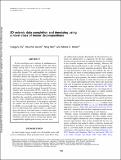| dc.contributor.author | Aeron, Shuchin | |
| dc.contributor.author | Hao, Ning | |
| dc.contributor.author | Kilmer, Misha E. | |
| dc.contributor.author | Ely, Gregory Tsiang | |
| dc.date.accessioned | 2015-09-15T14:59:32Z | |
| dc.date.available | 2015-09-15T14:59:32Z | |
| dc.date.issued | 2015-06 | |
| dc.date.submitted | 2015-03 | |
| dc.identifier.issn | 0016-8033 | |
| dc.identifier.issn | 1942-2156 | |
| dc.identifier.uri | http://hdl.handle.net/1721.1/98498 | |
| dc.description.abstract | We have developed a novel strategy for simultaneous interpolation and denoising of prestack seismic data. Most seismic surveys fail to cover all possible source-receiver combinations, leading to missing data especially in the midpoint-offset domain. This undersampling can complicate certain data processing steps such as amplitude-variation-with-offset analysis and migration. Data interpolation can mitigate the impact of missing traces. We considered the prestack data as a 5D multidimensional array or otherwise referred to as a 5D tensor. Using synthetic data sets, we first found that prestack data can be well approximated by a low-rank tensor under a recently proposed framework for tensor singular value decomposition (tSVD). Under this low-rank assumption, we proposed a complexity-penalized algorithm for the recovery of missing traces and data denoising. In this algorithm, the complexity regularization was controlled by tuning a single regularization parameter using a statistical test. We tested the performance of the proposed algorithm on synthetic and real data to show that missing data can be reliably recovered under heavy downsampling. In addition, we demonstrated that compressibility, i.e., approximation of the data by a low-rank tensor, of seismic data under tSVD depended on the velocity model complexity and shot and receiver spacing. We further found that compressibility correlated with the recovery of missing data because high compressibility implied good recovery and vice versa. | en_US |
| dc.description.sponsorship | National Science Foundation (U.S.). Graduate Research Fellowship (Grant DGE-0806676) | en_US |
| dc.description.sponsorship | National Science Foundation (U.S.). Division of Computing and Communication Foundations (Grant NSF-1319653) | en_US |
| dc.language.iso | en_US | |
| dc.publisher | Society of Exploration Geophysicists | en_US |
| dc.relation.isversionof | http://dx.doi.org/10.1190/GEO2014-0467.1 | en_US |
| dc.rights | Article is made available in accordance with the publisher's policy and may be subject to US copyright law. Please refer to the publisher's site for terms of use. | en_US |
| dc.source | Society of Exploration Geophysicists | en_US |
| dc.title | 5D seismic data completion and denoising using a novel class of tensor decompositions | en_US |
| dc.type | Article | en_US |
| dc.identifier.citation | Ely, Gregory, Shuchin Aeron, Ning Hao, and Misha E. Kilmer. “5D Seismic Data Completion and Denoising Using a Novel Class of Tensor Decompositions.” GEOPHYSICS 80, no. 4 (June 8, 2015): V83–V95. © 2015 Society of Exploration Geophysicists | en_US |
| dc.contributor.department | Massachusetts Institute of Technology. Department of Earth, Atmospheric, and Planetary Sciences | en_US |
| dc.contributor.department | Massachusetts Institute of Technology. Earth Resources Laboratory | en_US |
| dc.contributor.mitauthor | Ely, Gregory Tsiang | en_US |
| dc.relation.journal | Geophysics | en_US |
| dc.eprint.version | Final published version | en_US |
| dc.type.uri | http://purl.org/eprint/type/JournalArticle | en_US |
| eprint.status | http://purl.org/eprint/status/PeerReviewed | en_US |
| dspace.orderedauthors | Ely, Gregory; Aeron, Shuchin; Hao, Ning; Kilmer, Misha E. | en_US |
| dc.identifier.orcid | https://orcid.org/0000-0003-0879-4768 | |
| mit.license | PUBLISHER_POLICY | en_US |
| mit.metadata.status | Complete | |
